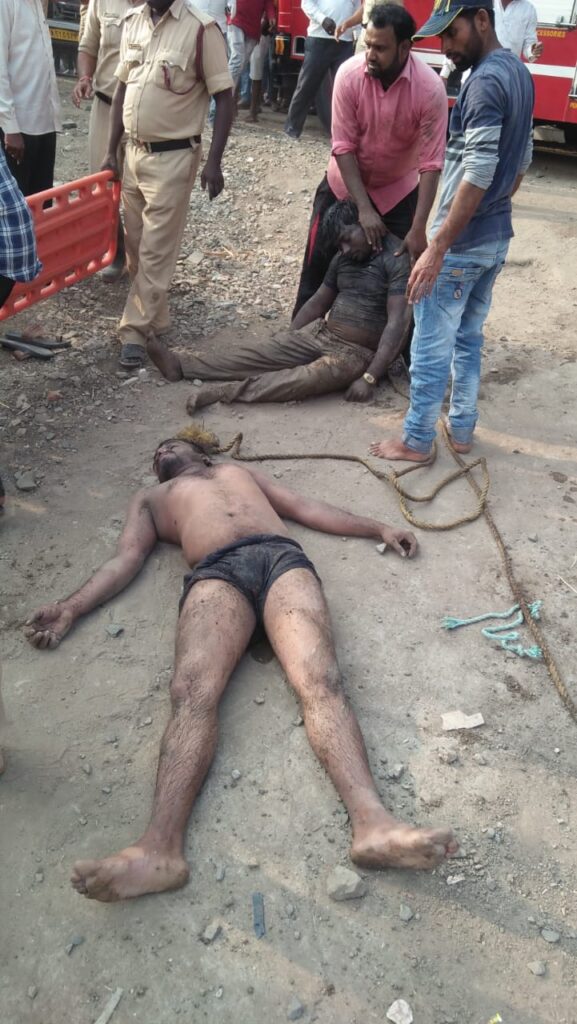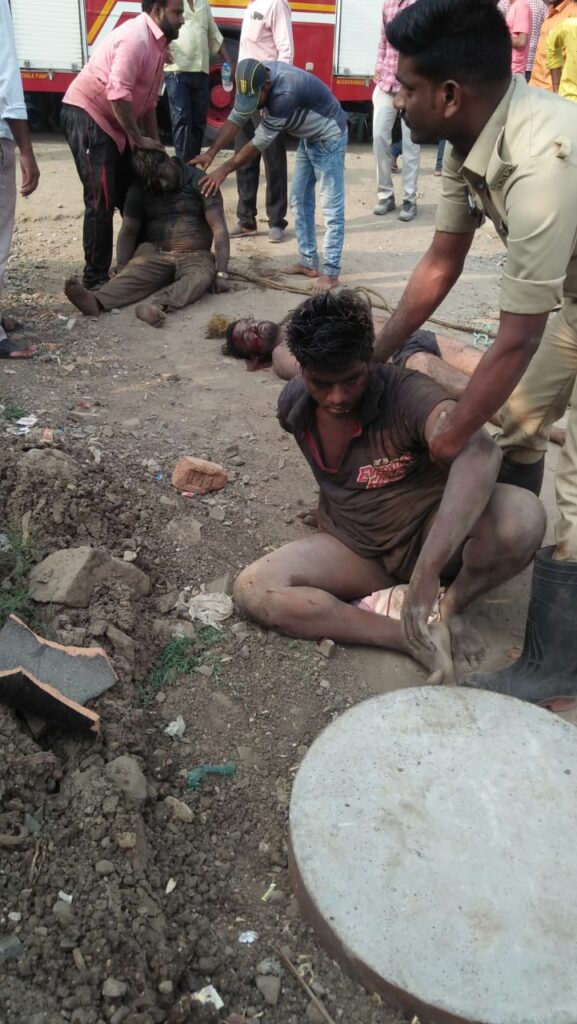The manufacturing unit (Unit 23) of Shahi Exports Private Limited (one of the largest garments’ exporter in India) located in Beretana Agrahara on Hosur Main Road has over 2,300 workers working over three shifts a day. Several toilets have been constructed for these workers and the sewage from these toilets flows into a Sewage Treatment Plant (STP) with a treatment capacity of 150 kLD. The inflowing sewage is collected in a 1000kL collection tank from which it enters the Aeration Tank (15 kL capacity) where primary treatment occurs. This partially treated sewage from the aeration tank is then sent to a Clarifier Tank where the separation of the solids from the liquid content of the sewage takes place, and the liquid part flows to the Filter Feed Tank as shown in the schematic below.

The Filter Feed Tank has a submersible pump through which liquid is pumped to the next unit in the treatment process. The depth of the Filter Feed tank is about 10 feet and the breadth is about 15-18 feet. This Filter Feed Tank is not designed for human entry. It has a very small entry, and no in-built ladder arrangement for climbing down.

The access to the entry point of the Filter fFeed Tank is also extremely cramped and congested. Ordinarily, the Filter Feed Tank should contain only liquid content and no solid content should enter the tank, but either because of bad design or improper functioning of the Sewage Treatment Plant, a lot of sludge had accumulated inside the Filter Feed Tank. According to an employee of Shahi Exports, the solidified sewage was 1 feet deep, and thus the tanks required to be cleaned.
On 23rd December 2023, two maintenance workers – Mr. K. Anand (44 years), a native of Andhra Pradesh belonging to Kamsala caste and Mr. T R Shashikumar (51 years), a native of Tamil Nadu. belonging to Naidu caste – were asked to enter inside the Filter Feed Tank and clean it with their bare hands. A utility ladder (see the image below) was given to them for climbing down the 10-ft deep tank. Clearly, they had no prior knowledge or training on the precautions to be undertaken while entering a confined space which had accumulated sludge in it. According to the General Manager of the factory, Mr. Suresh, the tank hadn’t been cleaned for 3 years. Because of the presence of untreated sludge for such a long period, that too in an almost completely closed tank with only a small opening, the tank is likely to have contained a high concentration of gases.

Mr. Anand was the first one to enter the tank at about 2:45 pm and when he stopped responding, Mr. Shashikumar also went inside. It is not clear if they were being supervised by anyone while they entered the tank. The General Manager of the factory feigned ignorance about whether any other staff of the factory was present at the spot or not or whether the work was being supervised by any staff of the factory. Before the unconscious workers were pulled out, they were inside the tank for about 30 minutes. They were rushed to Kaveri Hospital where they were declared dead. Both the workers had been working at the factory for a period of 2-3 years. The Sewage Treatment Plant had received Consent for Operation (CFO) in 2010 which was renewed in 2022 for a period of 10 years.
Mr. Sridhar (29 years), son of Mr. Shashikumar and Mr. Brahmayya (29 years) son of Mr. Anand were informed about the incident at around 3:30 PM and when they reached the hospital, they were informed about the deaths of their respective fathers. Based on a complaint by Mr. Sridhar, an FIR (CR No. 729/2023) was registered at the Parappana Agrahara Police Station u/s 7 and 9 of the Prohibition of Employment as Manual Scavengers and their Rehabilitation Act, 2013 and 34, 304 Part A of the Indian Penal Code against five persons: Nandish Gowda (Production General Manager), Rajesh Marar (Maintenance Deputy General Manager), Sreenivas (STP/ETP Incharge) and James Raju and Chandra Mohan (both HR).
While the registration of the FIR by the police under the PEMSR Act, 2013 is laudable, the invoking of the IPC Section 304 Part B (culpable homicide) instead of the much weaker IPC section 304 Part A (negligence) is warranted. The knowledge of the hazardous nature of the work that the two workers were made to carry out has to be assumed in light of the fact that the tank was not designed to be cleaned manually and such manual cleaning is banned under the law. Another serious lapse on the part of the investigating team was their failure to collect samples of the sludge present inside the tank. The FSL forensic team is reported to have collected only a sample of the gases present in the tank, which might help ascertain the cause of death but not the source of the gases which is important for the crime to be linked with the practice of manual scavenging.
When a team of officials, lawyers and activists visited the factory on 26th December 2023, i.e. three days after the incident, the company had not even started the process of disbursing compensation of Rs 30 lakhs to the family of each of the deceased worker, in accordance with the judgement of the Hon’ble Supreme Court in Dr. Balram Singh vs Union of India [Writ Petition 324 of 2020].
Unending Series of Deaths in STPs and Regulatory Vacuum
This fatal incident is the latest in an unending series of deaths in Sewage Treatment Plants in Bengaluru. Since 2016, seven such incidents have been documented (see Table 1) which have claimed 13 lives so far. After the 2016 notification issued by the Forest, Ecology and Environment Department in Karnataka, it has become mandatory for residential apartments meeting the specified threshold (in terms of area or number of housing units) to build and operate sewage treatment plants. Since these regulations were issued, the number of STPs have proliferated in Bangalore. While Bangalore Water Supply and Sewerage Board (BWSSB) mandates construction of STPs as a precondition for providing water connection, it doesn’t regulate the design, construction and maintenance of these STPs. The Karnataka State Pollution Control Board (KSPCB) also doesn’t regulate the design and operation of residential STPs beyond issuing Consent for Establishment (CFE) and Consent for Operation (CFO) under the Water (Prevention and Control of Pollution) Act, 1974. Often, CFEs are obtained by developers, who make every effort to save space while designing and constructing these STPs. Resultantly, most of the STPs are located underground in cramped and confined spaces. The developers then transfer the maintenance of the apartments to respective Residential Welfare Associations who are required to obtain and/or renew the CFOs. In many instances of such deaths, the STPs were found to be operating without a valid CFO, but KSPCB hadn’t taken any action to shut the plants down. In March 2021, the KSPCB had taken some tentative steps by issuing an Official Memorandum (OM) on STPs prescribing a few basic precautionary measures, but this OM was subsequently withdrawn citing lack of powers under the the Water (Prevention and Control of Pollution) Act, 1974 to make such prescriptions. This leaves us with a situation where, owing to these environmental regulations, thousands of killing fields in the form of sewage treatments plants have sprung up across the city, and while multiple authorities have been tasked with implementation of these regulations to protection the environment, none of these authorities are willing to shoulder the responsibility of protecting lives of those who are made to work at these treatment plants.
Recommendations
- Disbursal of compensation of Rs 30 lakh to the families of each of the deceased workers should be ensured in accordance with the judgement of the Hon’ble Supreme Court in Dr. Balram Singh vs Union of India [Writ Petition 324 of 2020].
- The families of Mr. Anand and Mr. Shashikumar should be provided with rehabilitation in accordance with the Prohibition of Employment as Manual Scavengers and their Rehabilitation Act, 2013.
- A comprehensive and effective regulatory framework for Sewage Treatment Plants (STP) should be enacted which should include suitable amendments to the following laws:-
- Municipal laws related to Building Plan approval to ensure safe design of STPs from the point of maintenance;
- The Water (Prevention and Control of Pollution) Act, 1974 governing the issuance of Consent for Establishment (CFE) and Consent for Operation (CFO) under which the terms of these consents should include safety protocols to be followed for maintenance of STPs
- Karnataka Apartment Ownership Act prescribing the obligations of the house-owners and the Residential Welfare Association (RWAs) with respect to ensuring safety of STP maintenance workers, provision of appropriate training and the punishment for non-discharge of these obligations.
| S. No. | Place of Incident | Date of Incident | No. of Persons Deceased | Name of the Deceased | Case Details |
|---|---|---|---|---|---|
| 1 | Shantinivas Apartment Goraguntepalya | 18.10.2016 | 2 | Venkatramana (24 years) Manjunath (30 years) | Yeshwanthpur PS CR 402/2016 |
| 2 | Jatti Dwarakamai Apartments, Whitefield | 24.04.2017 | 1 | Prithivi Raj (23 years) | Whitefield PS CR 197/2017 |
| 3 | ND Sepal Apartments Somasundarapalya | 06.01.2018 | 3 | Madegowda (45 years), Srinivas (52 years) Narayanswamy (43 years) | Bandepalya PS CR 6/2018 |
| 4 | Prestige Langleigh Apartments, ECC Road, Whitefield | 03.02.2018 | 1 | Rajappa (38 years) | Whitefield PS CR 46/2018 |
| 5 | Yamloka Restaurant AECS Layout | 13.02.2018 | 2 | Ramu (25 years) Ravi (28) | HAL PS CR 48/2018 |
| 6 | Prestige Falcon City Konanakunte | 04.02.2023 | 2 | Ravikumar (39 years) Dilip Kumar Jena (24 years) | Konanakunte PS CR 45/2023 |
| 7 | Shahi Exports Pvt Ltd., Hosur Main Road | 23.12.2023 | 2 | K Anand (41 years) T R Shashikumar (51 years) | Parappana Agrahara PS CR 729/2023 |



